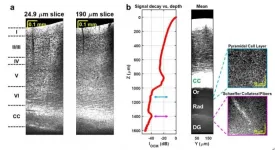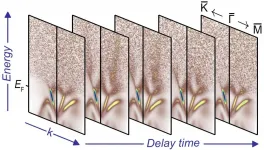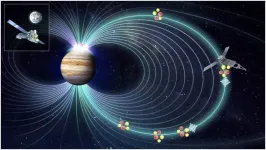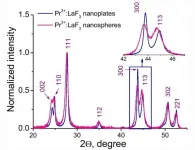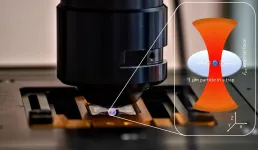Evaluation of India's 'Mission Indradhanush' finds improvements in vaccination outcomes
Researchers at CDDEP evaluated the performance of India's Mission Indradhanush (MI) child vaccination campaign to find an increase in vaccination rates and timeliness of vaccination.
2021-07-16
(Press-News.org) Washington, DC / New Delhi, India - Researchers at CDDEP recently published 'Improving vaccination coverage and timeliness through periodic intensification of routine immunization: evidence from Mission Indradhanush' where they evaluated the performance of India's Mission Indradhanush (MI) child vaccination campaign -- a periodic intensification of the routine immunization program.
Each year, 1.2 million Indian children die, accounting for a fifth of global under-5 deaths. Over 400,000 of these deaths are from vaccine-preventable diseases. An estimated 38% of Indian children under the age of two years were not-fully-immunized in 2016. Additionally, vaccinated children received 23%-35% of the doses of polio, diphtheria-pertussis-tetanus DPT, bacillus Calmette-Guérin (BCG), and measles vaccines at later than recommended ages. Low vaccination coverage and frequently delayed vaccinations stand in juxtaposition with India's rapid economic growth in recent decades.
In December 2014, the Government of India launched Mission Indradhanush (MI), with the objective of increasing full immunization coverage. MI was a periodic intensification of the routine immunization (PIRI) program which targeted unvaccinated and under-vaccinated children by allocating more resources to underserved areas. The program was implemented in 528 districts--with low initial full immunization coverage and high dropout rates--in four phases during March 2015-July 2017. An estimated 25.5 million children across India were vaccinated under MI in this time. Despite the substantial resources allocated towards this program, there has been a lack of robust estimates of its true impact.
The study reports on associations between the first and second phases of the MI program, and routine vaccination coverage and timing outcomes by employing difference-in-difference (DID) regression analysis which incorporates a rich set of socioeconomic and healthcare access indicators. The authors find that the full immunization rate was 27% higher among children under 2 years old residing in districts that received the campaign during both phase 1 and 2 (intervention group) as compared with those residing elsewhere (control group). The rate of receiving all vaccines at recommended ages was 8% higher in the intervention group. Receiving doses of oral polio vaccine (OPV) birth dose, OPV dose 1 (OPV1), OPV2, OPV3, BCG, and hepatitis B birth dose vaccines were 9%, 9%, 11%, 16%, 5%, and 19% higher in the intervention group than the control group, respectively. However, the study did not find improved vaccination rates for children who resided in a district that only received treatment in either phase 1 or 2.
According to the lead author of the study, Amit Summan, "Our findings hold tremendous importance for India's Universal Immunization Program. In the short term, MI-like programs could substantially boost vaccine coverage and on-time delivery rates. However, their long-term sustainability and resource allocation decisions for immunization will need to be evaluated further".
INFORMATION:
Improving vaccination coverage and timeliness through periodic intensification of routine immunization: evidence from Mission Indradhanush is published in the Annals of the New York Academy of Sciences and is available for download here: https://nyaspubs.onlinelibrary.wiley.com/doi/10.1111/nyas.14657
About the Center for Disease Dynamics, Economics & Policy Inc.
The Center for Disease Dynamics, Economics & Policy Inc. (CDDEP) produces independent, multidisciplinary research to advance the health and wellbeing of human populations around the world. CDDEP projects are global in scope, spanning Africa, Asia, and North America and include scientific studies and policy engagement. The CDDEP team is experienced in addressing country-specific and regional issues, as well as global challenges, such as antibiotic resistance and pandemic influenza. CDDEP research is notable for innovative approaches to design and analysis, which are shared widely through publications, presentations, and web-based programs. CDDEP has offices in Washington, D.C., and New Delhi and relies on a distinguished team of scientists, public health experts, and economists.
ELSE PRESS RELEASES FROM THIS DATE:
2021-07-16
Main points
Strong evidence that patients with pre-existent mental disorders are twice as likely to die or be hospitalised after SARS-CoV-2 infection
Psychotic and mood disorders are linked with COVID-19-associated mortality, as are exposure to antipsychotic and anxiolytic treatments.
Patients with substance use disorders are at increased risk of hospitalisation.
In the largest systematic review and meta-analysis to date on COVID-19 outcomes in individuals with psychiatric disorders, the odds of dying or being hospitalized following COVID-19 ...
2021-07-16
The team's findings, with important implications for ocean biogeochemistry and climate science, have been published by Nature Communications in a paper by Associate Professor Mark Holzer from UNSW Science's School of Mathematics & Statistics, with co-authors Tim DeVries (UCSB) and Casimir de Lavergne (LOCEAN).
"The deep North Pacific is a vast reservoir of remineralized nutrients and respired carbon that have accumulated over centuries," says A/Prof. Holzer. "When these deep waters are returned to the surface, their nutrients support biological production and their dissolved CO2 can be released into the atmosphere. As such, the deep Pacific plays a key ...
2021-07-16
Central nervous system (CNS) diseases such as Alzheimer's disease (AD) manifest early at the microscopic (i.e. cellular) level, deep in the brain. Yet, optical microscopes that can see cells in the living brain are superficial or invasive. Whole brain imaging techniques such as magnetic resonance imaging are deep and non-invasive, but lack cellular resolution.
In a new paper published in Light Science & Application, a team of scientists, led by Professor Vivek J. Srinivasan from the Departments of Ophthalmology and Radiology and Tech4Health Institute, ...
2021-07-16
Shizuoka, Japan - At Shikine Island, Japan, kelp forests and abalone fisheries were once common, but over the last twenty years they have disappeared. Now, researchers from Japan have discovered that these temperate coastal marine ecosystems are becoming more "simple", losing biodiversity, complexity and their aesthetic values.
In a study published this month, researchers from the University of Tsukuba and international collaborators explored how the combined effects of ocean warming and acidification are changing temperate coastal marine ecosystems.
Tropical coastal seas are synonymous with coral reefs. As ocean temperatures cool toward the poles, corals give way to kelp as the main habitat-forming species. The shift from coral to kelp can clearly be seen along the 2000 km ...
2021-07-16
The laws of quantum physics rule the microcosm. They determine, for example, how easily electrons move through a crystal and thus whether the material is a metal, a semiconductor or an insulator. Quantum physics may lead to exotic properties in certain materials: In so-called topological insulators, only the electrons that can occupy some specific quantum states are free to move like massless particles on the surface, while this mobility is completely absent for electrons in the bulk. What's more, the conduction electrons in the "skin" of the material are necessarily spin polarized, and form robust, metallic surface states that could be utilized as channels in which to drive pure spin currents on femtosecond ...
2021-07-16
An international research team led by YAO Zhonghua from the Institute of Geology and Geophysics of the Chinese Academy of Sciences (IGGCAS) has explained the cause of Jupiter's X-ray aurorae, a mystery that has puzzled scientists for 40 years.
The findings were published in Science Advances on July 9.
It is the first time planetary researchers have described the entire causality chain for Jupiter's X-ray auroral flares. The mechanism in producing X-ray auroral flares at Jupiter may have potential applications in X-ray astronomy.
The X-ray auroral spectra tell us these aurorae are produced by heavy ions with energies in the ...
2021-07-16
From the vocal cords that produce our voice, to our heartbeat, our body's cells are constantly subjected to mechanical forces that steadily change their response to these stimuli, regulating vital processes, in healthy individuals and in diseases such as cancer alike. Nevertheless, despite their importance, we remain largely ignorant of how cells sense and respond to these forces.
Now, an international team co-led by the researcher Pere Roca-Cusachs, from the Institute for Bioengineering of Catalonia (IBEC), and Isaac Almendros, a researcher at the Respiratory Diseases Networking Biomedical Research Centre (CIBERES) and IDIBAPS, both professors at the Faculty of Medicine and Health Sciences of the University of Barcelona (UB), has proved that what determines mechanical ...
2021-07-16
The article represents the transmission electron microscopy (TEM) and flow cytometry study of A-549 (human lung carcinoma) cellular uptake of Pr3+:LaF3 nanoparticles. The Pr3+:LaF3 nanoparticles are promising platforms for cell nano-sensors.
The objective of the work was to study the influence of nanoparticle morphology (nanoplates and nanospheres) on cytotoxicity and the dynamic of cellular uptake.
In the flow cytometry method, the cells go through a small tube (as a flow) and are irradiated by a laser. Cells scatter the laser light, and this scattering ...
2021-07-16
Measurements of biomechanical properties inside living cells require minimally invasive methods. Optical tweezers are particularly attractive as a tool. It uses the momentum of light to trap and manipulate micro- or nanoscale particles. A team of researchers led by Prof. Dr. Cornelia Denz from the University of Münster (Germany) has now developed a simplified method to perform the necessary calibration of the optical tweezers in the system under investigation. Scientists from the University of Pavia in Italy were also involved. The results of the study have been published in the journal Scientific Reports.
The calibration ensures that measurements of different samples and with different devices are comparable. ...
2021-07-16
The ability to predict and interpret modifications of ribonucleic acid (RNA) has been a welcome advance in biochemistry research.
However, existing predictive approaches have a key drawback--they can only predict a single type of RNA modification without supporting multiple types or providing insightful interpretation of their prediction results.
Researchers from Xi'an Jiaotong-Liverpool University, led by Dr Jia Meng, have addressed this issue by developing a model that supports 12 RNA modification types, greatly expanding RNA research prediction and interpretation.
"To the best of our knowledge, ...
LAST 30 PRESS RELEASES:
[Press-News.org] Evaluation of India's 'Mission Indradhanush' finds improvements in vaccination outcomes
Researchers at CDDEP evaluated the performance of India's Mission Indradhanush (MI) child vaccination campaign to find an increase in vaccination rates and timeliness of vaccination.
